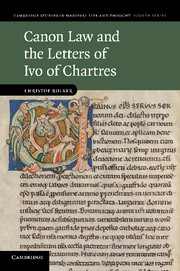Book contents
- Frontmatter
- Contents
- List of abbreviations
- Note on the citation of manuscripts
- 1 IVO OF CHARTRES – ‘LIFE AND LETTERS’?
- 2 CANON LAW BEFORE IVO
- 3 COLLECTIONS KNOWN TO OR COMPILED BY IVO
- 4 THE CANON LAW IN IVO'S CORRESPONDENCE
- 5 HIERARCHIES OF AUTHORITY: IVO's VIEWS ON DIVINE LAW AND THE ECCLESIASTICAL HIERARCHY
- 6 THE LAWS OF MARRIAGE: ‘QUOD ET NATURA DISPOSUIT, ET LEX TAM ECCLESIASTICA QUAM MUNDANA FIRMAVIT’
- 7 IVO'S DECRETUM AND THE PANORMIA: CHARACTER, RECEPTION, AUTHORSHIP
- 8 IVO'S PASTORAL CANON LAW AND HIS PLACE IN LEGAL HISTORY
- Appendix: A concordance table for the quotations in Ivo's letters
- Bibliography
- Index to single letters of Ivo of Chartres
- Manuscript index
- General index
7 - IVO'S DECRETUM AND THE PANORMIA: CHARACTER, RECEPTION, AUTHORSHIP
Published online by Cambridge University Press: 04 August 2010
- Frontmatter
- Contents
- List of abbreviations
- Note on the citation of manuscripts
- 1 IVO OF CHARTRES – ‘LIFE AND LETTERS’?
- 2 CANON LAW BEFORE IVO
- 3 COLLECTIONS KNOWN TO OR COMPILED BY IVO
- 4 THE CANON LAW IN IVO'S CORRESPONDENCE
- 5 HIERARCHIES OF AUTHORITY: IVO's VIEWS ON DIVINE LAW AND THE ECCLESIASTICAL HIERARCHY
- 6 THE LAWS OF MARRIAGE: ‘QUOD ET NATURA DISPOSUIT, ET LEX TAM ECCLESIASTICA QUAM MUNDANA FIRMAVIT’
- 7 IVO'S DECRETUM AND THE PANORMIA: CHARACTER, RECEPTION, AUTHORSHIP
- 8 IVO'S PASTORAL CANON LAW AND HIS PLACE IN LEGAL HISTORY
- Appendix: A concordance table for the quotations in Ivo's letters
- Bibliography
- Index to single letters of Ivo of Chartres
- Manuscript index
- General index
Summary
IVO'S DECRETUM AND THE PANORMIA COMPARED
The evidence from the letters calls for a reassessment of the relation between the Decretum and the Panormia. Fournier's model suggests that both originated almost at the same time, and that the Decretum was only a preparatory collection. According to him, only the Panormia was intended for circulation. The difference between Decretum and Panormia, Fournier held, was only the degree of systematic reworking; the two collections appeared as two stages of one work. This model remained the standard account; it generally did not encourage scholars to study the differences between the Decretum and the Panormia in detail.
However, the findings presented in the previous chapters all suggest that the diff erences between the collections have been seriously underestimated so far. As argued in Chapter 3, the formal sources of the collections differ sharply. None of the collections employed for the Decretum (or any other Ivonian collection) was used independently for the Panormia, while the distinctive sources of the latter have no role to play in the making of any of the other Ivonian collections. As the discussion in Chapter 4 sought to show, Ivo's letters reflect an intimate acquaintance with the Decretum, though he also drew on other sources, most notably Tripartita A. The Panormia, on the other hand, has no discernible part to play from the first letters to the last. In addition, as argued in Chapter 5, the Decretum echoes the method of ‘mercy and justice’ outlined in Ivo's Prologus and the letters.
- Type
- Chapter
- Information
- Canon Law and the Letters of Ivo of Chartres , pp. 248 - 289Publisher: Cambridge University PressPrint publication year: 2010



